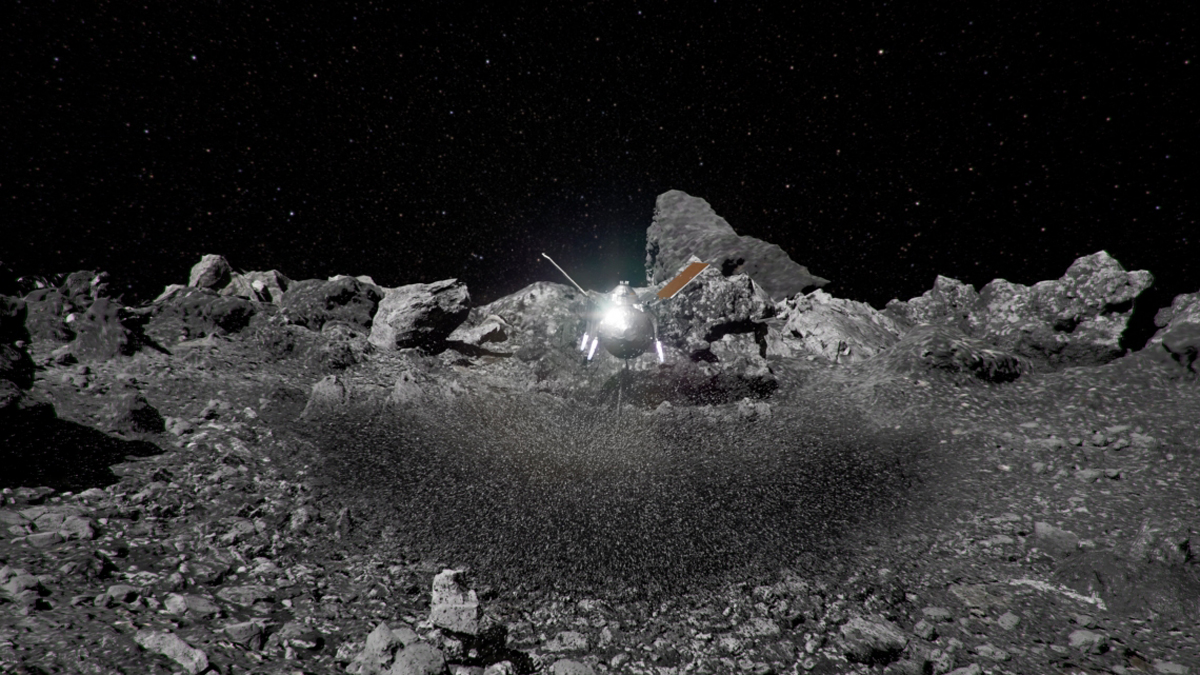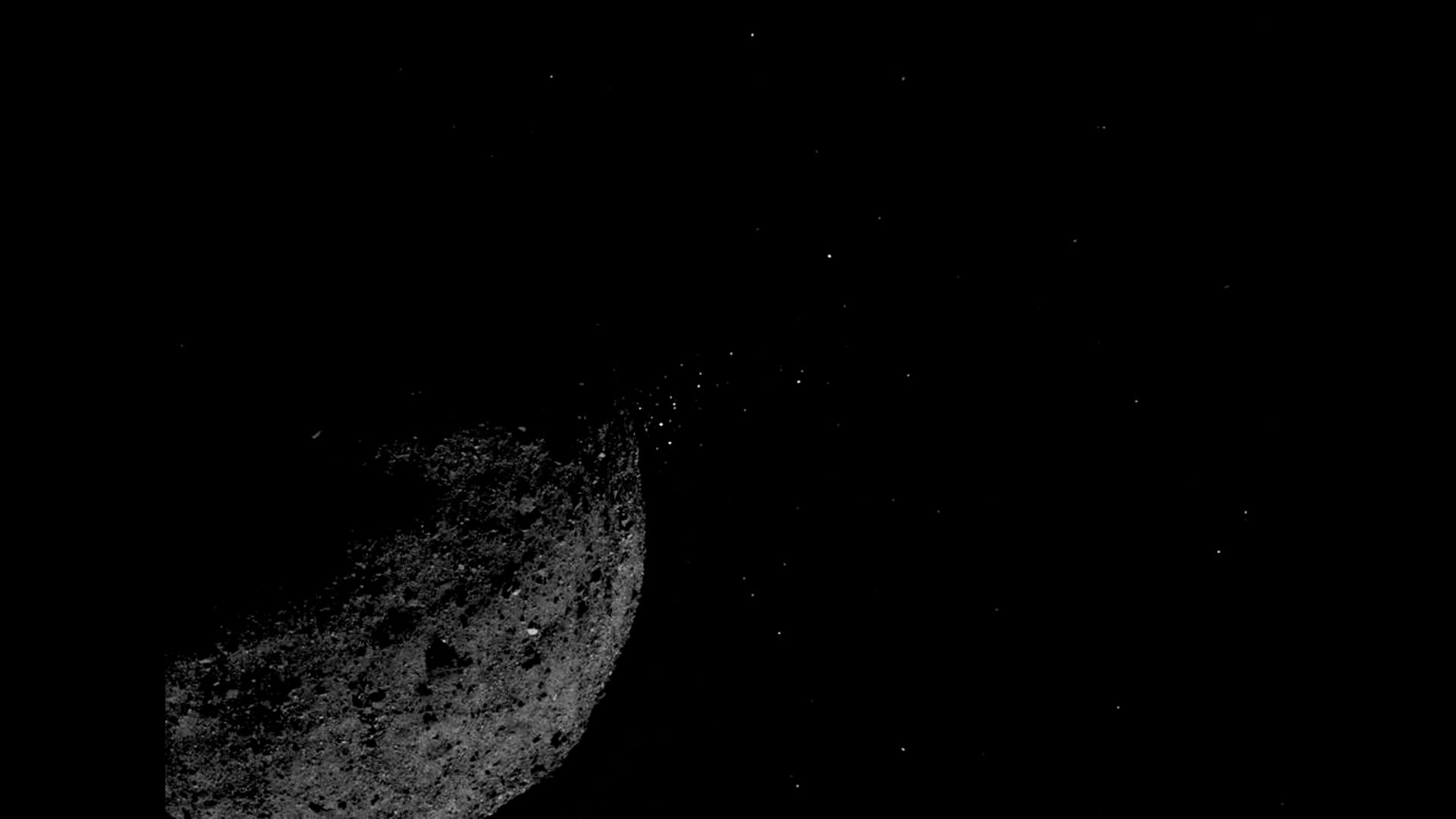Dramatic sampling shows asteroid Bennu is nothing like scientists expected
"The surface was soft and flowed away like a fluid."

NASA's OSIRIS-REx mission unleashed an unexpected explosion when it touched down on asteroid Bennu in October 2020 to collect a precious sample to carry home to Earth.
Mission scientists have described the dramatic sample retrieval, which led to surprising discoveries about the asteroid's nature, in two new studies. And the results aren't just intriguing: The researchers say that the findings might have implications for a possible future deflection mission, should the 1,640-feet-wide (500 meters) Bennu (one of the riskiest known near-Earth asteroids) ever threaten to impact the planet.
"We expected the surface to be pretty rigid, kind of like if you touch down on a gravel pile: a little bit of dust flying away and a few particles jumping up," Dante Lauretta, a planetary scientist at the University of Arizona and principal investigator of the OSIRIS-REx, mission told Space.com.
"But as we were bringing back the images after the event, we were stunned," he continued. "We saw a giant wall of debris flying away from the sample side. For spacecraft operators, it was really frightening."
Related: Asteroid Bennu's mysterious missing craters suggest 'impact armoring' protecting the surface
The impact aftermath was so unexpected that Lauretta, lead author of one of the two studies, campaigned for the spacecraft to revisit the area to understand what happened. Six months after sample collection, in April 2021, the researchers got another glimpse of the OSIRIS-REx touchdown site. When the spacecraft first arrived at Bennu, that site, called Nightingale, sat within a 65-foot-wide (20 m) impact crater. After touchdown, mission scientists found a brand new 26-foot-wide (8 m) gaping hole in the surface, with displaced rubble and boulders scattered around the site.
That's a surprisingly large scar; scientists had expected to scoop out a bit about as wide as the sample collector itself, 12 inches (30 centimeters). "But we sunk in," Lauretta said. "There clearly was no resistance whatsoever. The surface was soft and flowed away like a fluid."
Get the Space.com Newsletter
Breaking space news, the latest updates on rocket launches, skywatching events and more!
The probe sank as deep as 30 inches (70 cm), revealing pristine material that, unlike the asteroid's surface, was unaltered by the steady battering of cosmic rays and the solar wind, the streams of high-energy particles from the sun.
From the measurements acquired during this repeat visit, Lauretta's team calculated that the density of the surface material was only about 31 to 44 pounds per cubic foot (500 to 700 kilograms per cubic meter), Lauretta said. For comparison, "a typical Earth rock" has a density about six times higher, more like 190 pounds per cubic foot (3,000 kilograms) per cubic meter.
A second study, based on measurements of forces exerted on the probe during the impact, confirmed those numbers.

"The [surface] boulders are very porous and there is a lot of void space between them," Kevin Walsh, a geologist at the Southwest Research Institute in Colorado and lead author of the second study, told Space.com. "We expected that small, fine grains and dust would stick to the large boulders and fill the void space and act as a glue to provide some strength, which would allow the surface to push back against the spacecraft more. But it's not there."
Bennu's soft, fluffy nature may complicate a possible future deflection attempt, should astronomers determine the rock threatens to hit Earth. At 1,640 feet wide, a strike by Bennu would cause continent-wide disruption on our planet. And even though NASA estimates the chance of collision at 1 in 2,700 between the years 2175 and 2199, Bennu is still one of the most dangerous asteroids currently known.
Moreover, scientists assume that many asteroids sport a similar "rubble pile" structure: essentially conglomerations of rock, gravel and dirt held together by weak gravitational forces. The sampling experiment at Bennu shows that it's almost impossible to predict how such a rubble pile might respond to an impact.
"The touchdown did provide the first experience of really pressing something into the surface," Walsh said. "And if we ever go and actually try to deflect something like this, we would need to know what the surface is like so that it doesn't just absorb the impact."
Lauretta added that the underground material appeared more red compared to the bluish surface of Bennu, which suggests that cosmic rays and other forms of space weather erode the exposed space rocks. The reddish hues hint that organic molecules, like hydrocarbons, may be present inside the asteroid, which greatly interests researchers trying to understand the origins of life on Earth.
The scientists will have to wait until OSIRIS-REx's scheduled delivery in September 2023 to get their hands on the precious material. During the dramatic sampling attempt, the probe collected almost 9 ounces (250 grams) of asteroid dust, which is somewhat less than the teams had hoped for but still four times more than they need to conduct the analysis, said Lauretta.
The OSIRIS-REx mission was recently extended and after the spacecraft drops off its cargo at Earth next year, it will head to Apophis, another high-risk asteroid, which it will visit in 2029.
The results are described in papers published Thursday (July 7) in the journals Science and Science Advances.
Follow Tereza Pultarova on Twitter @TerezaPultarova. Follow us on Twitter @Spacedotcom and on Facebook.
Join our Space Forums to keep talking space on the latest missions, night sky and more! And if you have a news tip, correction or comment, let us know at: community@space.com.

Tereza is a London-based science and technology journalist, aspiring fiction writer and amateur gymnast. Originally from Prague, the Czech Republic, she spent the first seven years of her career working as a reporter, script-writer and presenter for various TV programmes of the Czech Public Service Television. She later took a career break to pursue further education and added a Master's in Science from the International Space University, France, to her Bachelor's in Journalism and Master's in Cultural Anthropology from Prague's Charles University. She worked as a reporter at the Engineering and Technology magazine, freelanced for a range of publications including Live Science, Space.com, Professional Engineering, Via Satellite and Space News and served as a maternity cover science editor at the European Space Agency.









